A Brief History and Evolution of Weapons

source
Weapons are devices used in offensive or defensive fighting to destroy, defeat, or injure an enemy. Offense types of weapons are also used for hunting game to provide food for man.
Defensive weapons, such as a shield, a bullet-proof vest, or a bomb shelter, are used for protection. This article, as most discussions of weapons, deals only with offensive weapons, those with reach out and strike the enemy, such as a spear, a gun, or a bomb.
The first weapon was probably the stone thrown by hand. Primitive man must have discovered early that by placing the stone in a sling, more distance and greater impact were attainable. Later, he shaped stones and used them as spearheads. Sometimes, he imbedded stones in the trunks of young trees. When the trees had grown firmly around the stones, he cut the tree above and below the stones to produce sturdy stone axes. Eventually man was to develop the bow, using stones for arrowheads.
A primitive stone spearhead.
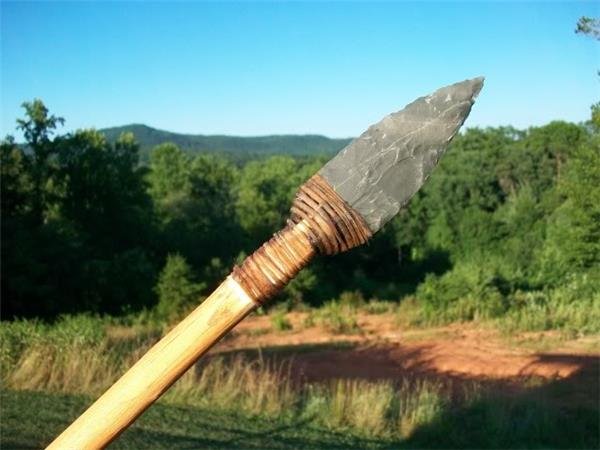
source
About 5,000 BC, copper, which was one of the first metals known to man, was first mined in the uncombined state. After this discovery until about 1000 BC, spearheads, arrowheads, knives, and swords were made of copper or its alloy, bronze, Iron, which was discovered about the same time that bronze was first made, was soon used to replace bronze in weapons.
This picture shows copper alloy ingots, examples of bronze axe-heads from early to late Bronze Age, and some spearheads.
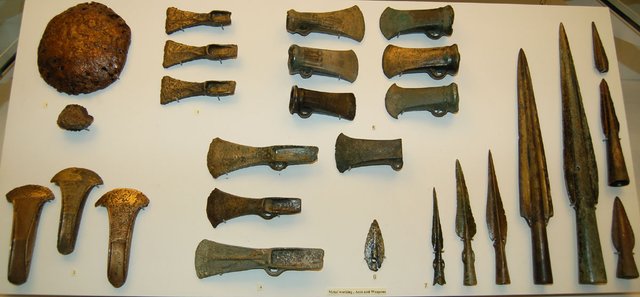
source
The composite bow, a powerful variation of the bow, was developed in Asia. This bow was made of three different materials bonded together to provide a strong spring action. Bows of this type usually had a reflex action when the bow was strung, it bent in the direction opposite to that when unstrung.
Here's an example of a bow made of composite materials that's also very long.
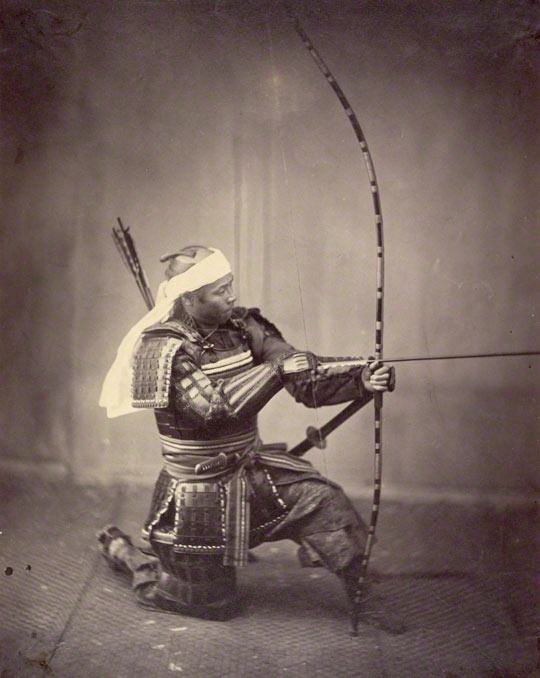
source
From 200 BC to 400 AD, the Romans made a great contribution to the development of war engines. They invented the battering ram, catapults, (giant slingshots) , and fighting towers.
Battering rams
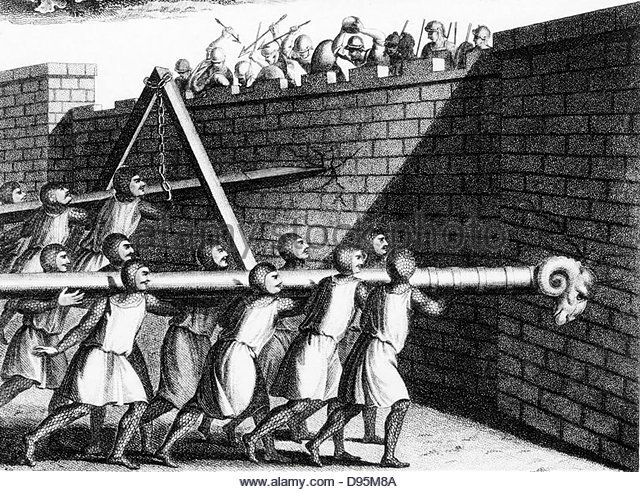
source
Catapult
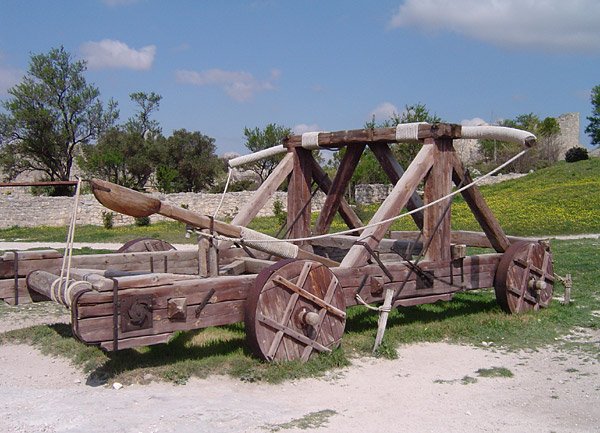
source
During the medieval centuries, refinements of older weapons continued. The long bow (five to six feet long) became popular because of its greater penetration and accuracy. The even more powerful crossbow was also developed at this time.
Crossbow
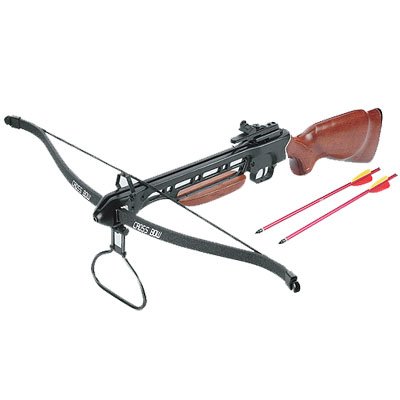
source
Gunpowder was first used to fire cannons in early 1300 AD. The early cannons were made of wood and fired large spears. Gradually, metal cannons came into use. The earlier models fired stones; the later ones fired lead balls. Smaller versions of the cannon were held in the hands. Burning ropes and hot iron rods were used to set off the gunpowder in these devices. Hand guns were improved during the 16th century with the invention of the matchlock, a device which automatically ignited the powder each time the trigger was pressed. Variations of igniters included both stone and metal spark makers.
Chinese Taoist alchemists combined sulphur, saltpeter and charcoal to make the earliest form of huoyao, or gunpowder, during the eighth-century Tang Dynasty. It was used to kill insects and treat skin diseases before its weaponry advantages were realized.
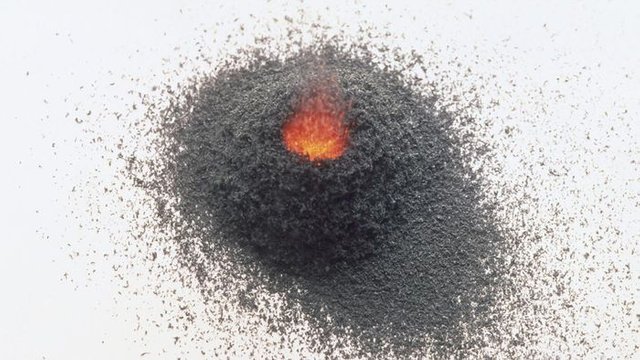
source
A primitive cannon (A sample of the earliest gunpowder weapon)
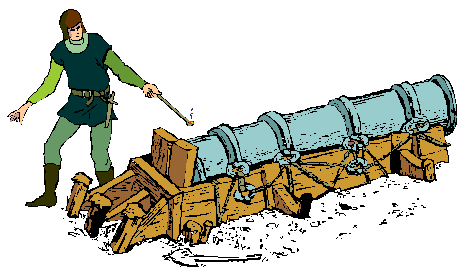
source
As cannons were perfected, they became more useful on board ships. In early 1500, special short-barreled cannons, called mortars were designed to fire at a steep angle and drop their charges on their target. From 1500 to 1700, mobile artillery pieces were developed. By the use of protractors and levels, cannons were aimed for effective firing. Bombs also came into use during this period. Instead of a solid metal ball, a hollow sphere filled with explosive material was fired from the cannon.
A 60mm mortar round being launched
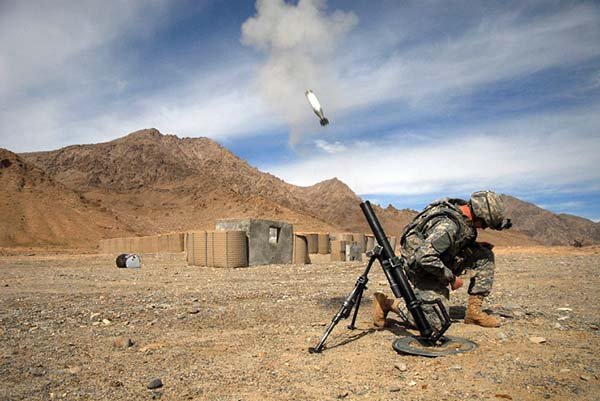
source
In the early 1600's, the Germans invented the basic rifle as it is known today. Instead of having a smooth bore like the other handguns, a spiral, or rifled, groove was cut into the barrel. When a slightly oversized ball was forced out of the barrel, it threaded its way along the spiral and continued to spin after it left the muzle. The spin maintained an accurate line of fire, whereas the projectile without spin wobbled and followed an unpredictable trajectory. The Kentucky rifle, developed from the German design, was of smaller bore diameter and lighter in weight. It had a flintlock (flint striking steel) firing mechanism and a leather-covered bullet. This type of charge was easier to insert into the rifled bore from the muzzle, and it offered superior accuracy up to 100 yards.
Kentucky rifle
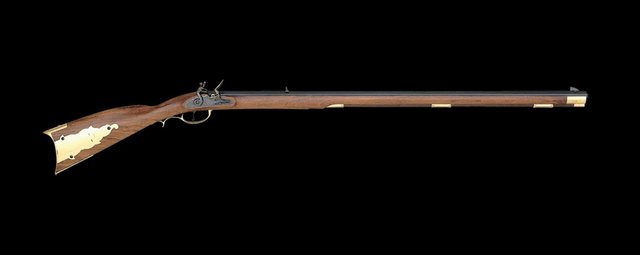
source
A flintlock pistol
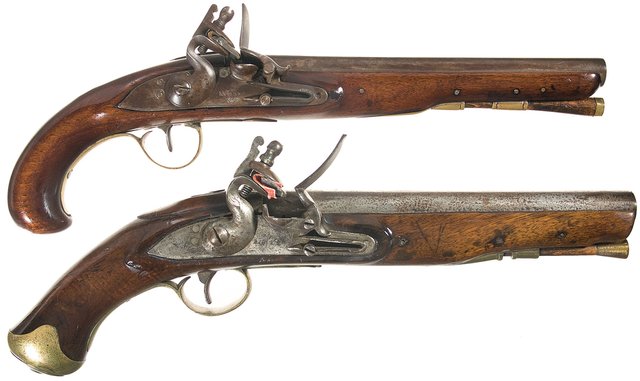
source
About 1800, a major change in loading rifles occurred. Until this time, charges were rammed down the barrel from the muzzle end of the gun. The breech-loading rifle, loading from the firing-chamber end of the barrel, was invented. Also the percussion principle of firing gunpowder was developed. By striking a sharp blow to a mild but sensitive explosive, the gunpowder could be ignited. The matchlock was thus no longer needed.
The breech-loading rifle

source
The French Minie balls replaced the round lead balls because of their improved performance. Although called a ball, it was the first streamlined bullet that proved practical.
The minie ball bullet
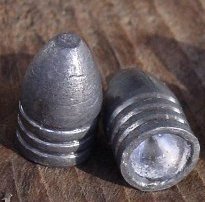
source
Small handguns or pistols found a good market in 19th century. One of the most famous was the Derringer. Colt's patent Revolver, invented in 1836, was one of the first successful, repeating action guns. It is the forerunner of present-day hand guns. In the latter half of the 1800's, bullets with self-contained primers were invented. The expanding gases of the explosion forced the wall of the shell tightly against the chamber to prevent the loss of its pressure. The hollow base of the bullet also expanded and followed the spiral riflings down the barrel. This cartridge principle is now used on all guns except for large cannons.
The original Colt revolver
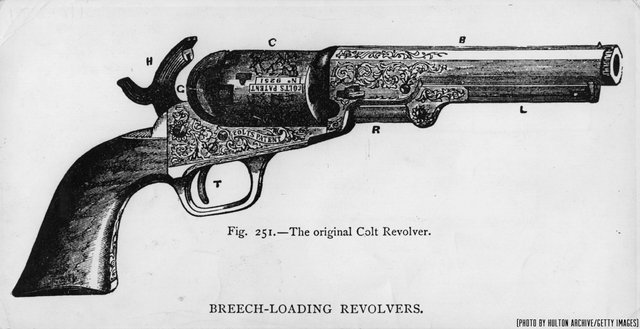
source
This is a sample of a modern bullet. In the bottom of a round of ammunition, you'll find the primer.
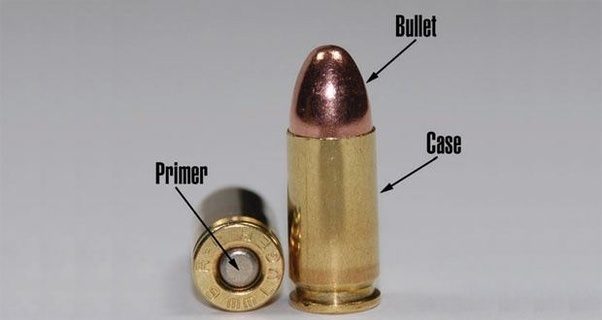
source
Small arms, 60 caliber (diameter of projectile in inches) and under, have developed rapidly during the past 100 years. Automatic pistols became popular after 1900 when revolvers remained relatively unchanged. Rifles progressed from single shot to repeaters. The armed forces now use semi-automatic and fully automatic rifles. A semi-automatic rifle fires each time the trigger is pulled. The explosive gas pressure is utilized to load the next cartridge. An automatic rifle continues to fire as long as the trigger is pressed and the supply of the bullets holds out.
The experimental Kalashnikov assault rifle of 1947, also known as AK-47, first model (automatic rifle)
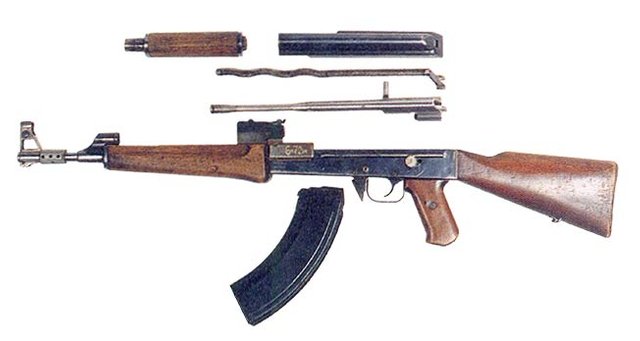
source
A modern AK 107 / 108 firing system animation

source
Shotguns use paper-covered cartridges which contain many small balls, or "shot." The shot spreads out over a relatively large area, and is very effective for hunting small game.
A Winchester M1897, one of the first successful pump-action shotgun designs

source
Vintage Shotgun Cartridges
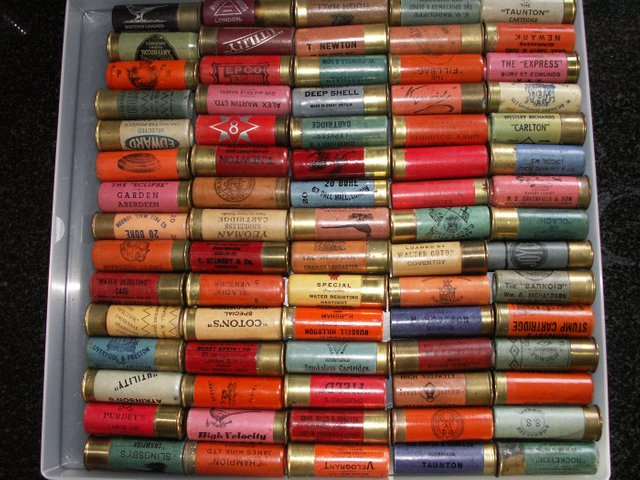
source
Another type of small arms developed within the century is the machine gun. This gun fires great quantities of ammunition in a short time. The Gatling gun, developed during the Civil War and used in the Spanish War, was operated by a hand crank. The Crank rotated ten barrels past one firing point so that a firing rate of 800 shots per minute could be attained. Thhis principle is used today on jet fighter aircraft, the Vulcan cannon can fire 6000 rounds of 20mm ammunition per minute. Some machine guns are light enough to be carried by one man. However, two-man teams are not uncommon for moving these weapons. Most common machine guns have a single barrel, and work the same as the automatic rifle in principle. However, they use more ammunition and can fire for longer periods. Through World War II and the Korean War, machine guns were the main protective armament of all aircraft. Rockets and guided missiles are fast becoming standard armament in place of, or in addition to, machine guns.
British Vickers machine gun in action near Ovillers during the Battle of the Somme in 1916. The crew are wearing gas masks.
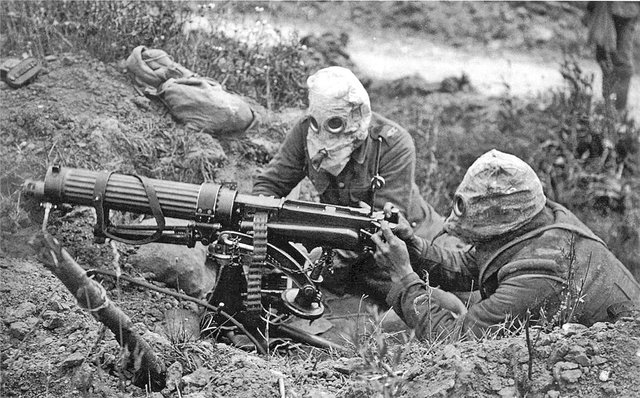
source
An 1862 model Gatling gun.
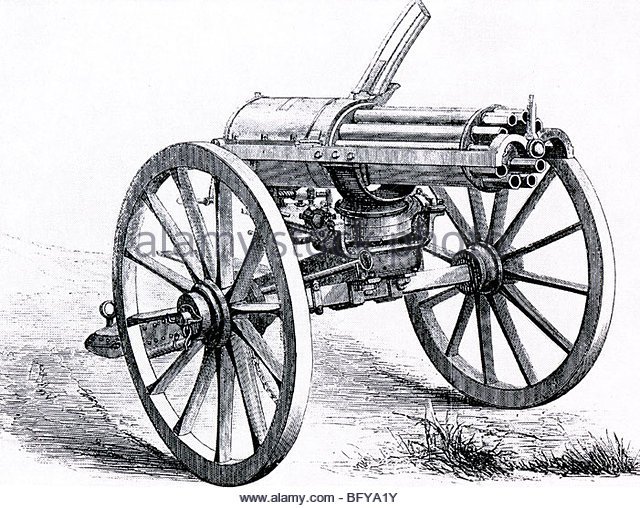
source
The Vulcan cannon

source
Cannons, defined as guns over .60 caliber, have similarly improved in operating efficiency during the past century. Rifling and copper-banded shells have made muzzle loading and smooth-bores obsolete. Ammunition as large as 20 inches in diameter has been used in combat, although 16-inch shells are the largest size now in use. Recoil mechanisms for absorbing the shock when firing weapons were one of the more desirable improvements. The early coastal defense guns were counter-weighted so they could be raised into firing position. When they were fired the tremendous recoil was damped by large piston-type shock absorbers. Various combinations of springs, hydraulic pistons, and compressed gases are now used to absorb recoil and return the gun barrel to firing position.
In World War I, when aircraft were first used, the anti-aircraft guns were a natural development. This gun was nothing more than a converted 75mm. cannon aimed in the same manner as a shotgun shooting ducks. A modern 75mm. gun called the "Skysweeper," has its own radar and computer unit which automatically tracks and fires at aircraft with deadly accuracy. Similarly, guided missiles are used by artillery and naval vessels to seek out flying targets automatically.
The Skysweeper
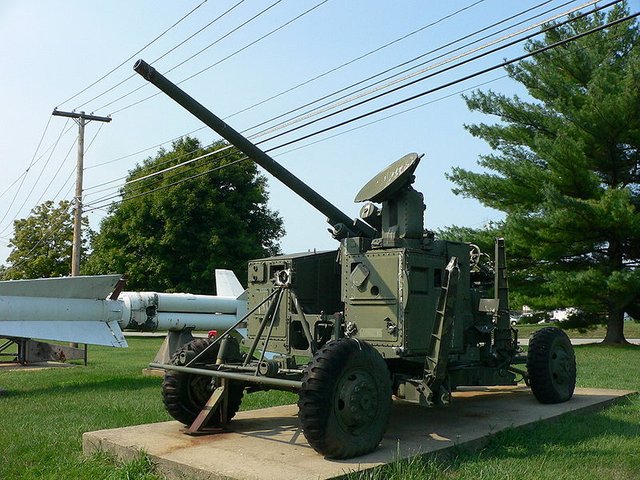
source
A sample of a guided missile launched by the US Navy
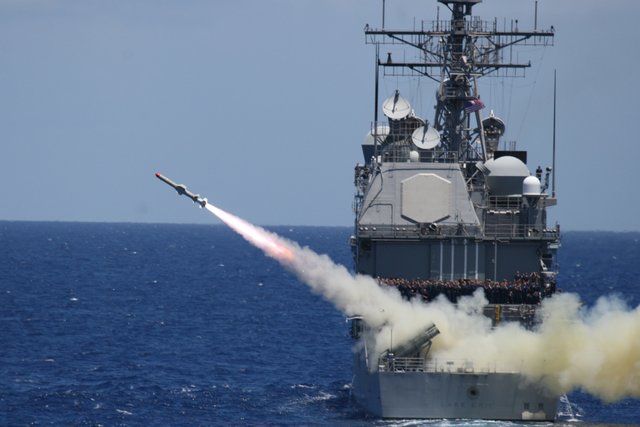
source
Cannons became quite mobile in World War I. Some were moved by rail; other heavy guns were pulled by tractors at 8 miles per hour. Heavier ones now can travel 50 to 60 m.p.h. Very few guns are now permanently positioned. Some are even self-propelled so that they do not have to be towed. The cannon is fast becoming obsolete since a guided missile can do more accurately almost every task of a cannon.
Other recent developments are serial bombs. Light-weight explosives were first dropped by hand from aircraft in World War I. Guided nuclear bombs of tremendous destructive power are now available as weapons in some countries. A water bomb, the torpedo, was designed for underwater demolition of ships.
The Consolidated B-24 Liberator is an American heavy bomber, designed by Consolidated Aircraft of San Diego, California. It was known within the company as the Model 32, and some initial models were laid down as export models designated as various LB-30s, in the Land Bomber design category.
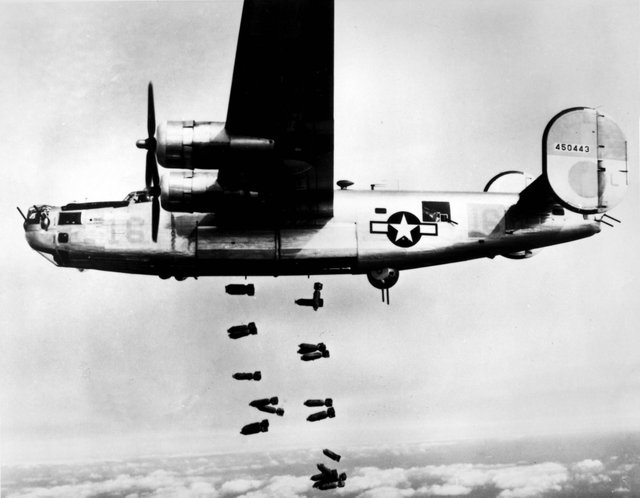
source
A computer generated image of a torpedo being launched from a submarine.
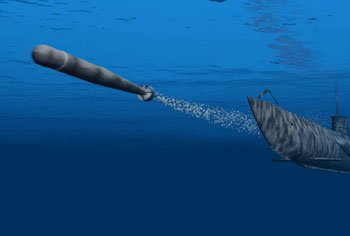
source
The armored machine gun destroyer, better known as a tank, became prominent during World War I. Armed with machine guns and protecting its crew with heavy armor plate, it could penetrate almost any enemy line at that time. Modern tanks carry cannons as well as machine guns. Of course, special weapons have been designed to knock out tanks. Anti-tank weapons include the hand grenade (a hand-thrown bomb) and the bazooka (a portable rocket launcher).
An armored tank.
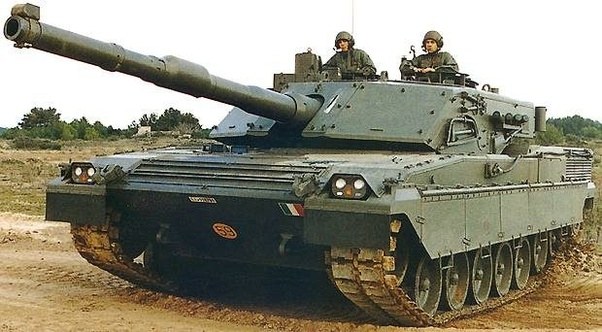
source
A hand grenade.
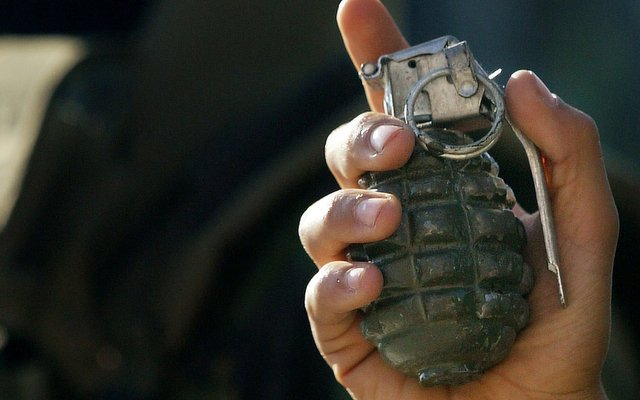
source
Soldier holding an M1 "Bazooka".
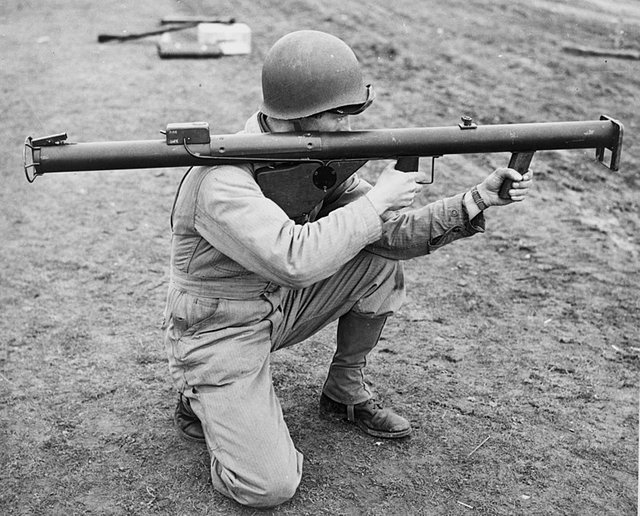
source
Mines are floated in water or hidden on land. They explode when approached or touched by personnel, vehicles, or vessels. Flamethrowers, both portable and tank-mounted, were developed during World War II, to shoot a stream of burning gasoline and oil into places where ordinary firearms could not penetrate.
A German contact mine laid in Australian waters during World War II
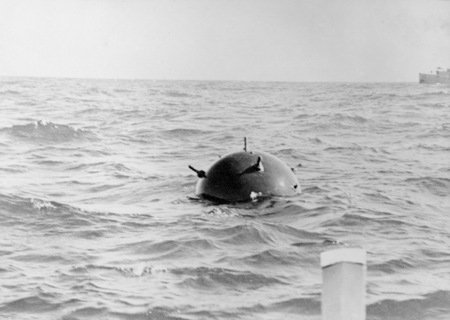
source
A flamethrower

source

References:
https://en.wikipedia.org/wiki/History_of_weapons
http://www.29palms.marines.mil/Units/MAWTS1/
https://www.newscientist.com/article/dn17423-timeline-weapons-technology/
http://www.warmuseum.org/evolution-of-weaponry.php
http://www.localhistories.org/weaponshist.html
http://www.29palms.marines.mil/Units/MAWTS1/
https://www.newscientist.com/article/dn17423-timeline-weapons-technology/
http://www.warmuseum.org/evolution-of-weaponry.php
http://www.localhistories.org/weaponshist.html
great piece. one thing I'd argue against is the "Thrown Rock" as being the original weapon. Paleontologist believe a handheld rock, stick or club would constitute the first weapon, and were not invented by modern humans, but rather our hominid relatives. Humans may have innovated projectiles, as it seems Neanderthals did not hurl their spears, but this is not certain, and I don't believe it, but it is an accepted theory. I just think it's awesomely interesting that the basis of weapons technology began with other species, and we adopted and innovated upon those beginnings.
Wow i'm thankful i used the word probable because i knew the prehistoric period is very arguable for everyone. However, the stone age weapons are almost nothing, but as you mentioned; relating the invention of the first weapon to other species, man that's so interesting!
got to use those qualifiers. probable is a great one. Yup, I'm totally interested in our great ape cousins, which I believe existed. I think that's where myths of elves and dwarves and such come from--reality. And I do strongly believe humanity inherited a great deal of tech before we innovated upon any of it.
This is incredible Oliver! Absolutely fascinating and extremely well put together... pulling all of this must have taken ages. Well done!
Hey Oliver, I think the link for the image of the catapult might be broken.
Thank you @aussieninja! I find this topic really interesting so i did put a little effort to share it here but in a short and simple yet comprehensive enough for readers not to fall asleep. I also learn through the whole process. I'll be following you.
Aside for being informative, the good illustrations and the sequences of weapons has taught me something new. I enjoyed reading. Thank you!
I've seen almost all in movies. Weapons also serve many other purposes in society including use in sports, collections for display, and historical displays and demonstrations... Cool historical article
You're never been wrong. Actually i'm hooked into airsoft guns lately as a hobby. Thanks!
Welcome ... That's cool
Congratulations @olivercuico, this post is the fifth most rewarded post (based on pending payouts) in the last 12 hours written by a Newbie account holder (accounts that hold between 0.01 and 0.1 Mega Vests). The total number of posts by newbie account holders during this period was 3617 and the total pending payments to posts in this category was $2403.87. To see the full list of highest paid posts across all accounts categories, click here.
If you do not wish to receive these messages in future, please reply stop to this comment.
Awesome post man.
It's amazing to think that the AK47 was designed in 1947. Imagine if it had actually been discovered a few years earlier (during WW2) and the effect it most probably would have had on the Russian war machine.
If I'm correct the STG-44 was it's predecessor and Kalashnikov based his design on the German gun. I know that he had expressed a lot of regret for ever designing the weapon due to the chaos it has caused.
An interesting post would be to look at what happened when different weapons met on the battlefield, as an example, when the British fought the Zulus in South Africa. Guns vs traditional zulu spears or iklwas / assegais
Keep up the good word!
The date of manufacturing itself was a probable proof that the STG-44 was the predecessor of AK. There are claims that the Kalashnikov designs copied the TKB-415 and AVS-31 (both Soviet Union guns) maybe said it for their pride sake or something else i do not know. haha!
Thank you Olivercuico for giving us an overview of the history of weapon. It is very well written and explained!
Thanks for reading my post @marijas! :-)
You have shared an insightful post about the evolution of weapons from a simple stick to high-quality shoot guns. Nowadays people are being use night vision goggles australia. These are night vision devices that help you while going in the dark to locate your target. They use powerful Lenz and a long-lasting battery that remains for 18 hours. You can visit the site to order now.